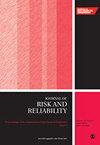工业系统的高级维护建模
IF 1.8
4区 工程技术
Q3 ENGINEERING, INDUSTRIAL
Proceedings of the Institution of Mechanical Engineers Part O-Journal of Risk and Reliability
Pub Date : 2023-05-11
DOI:10.1177/1748006X221149608
引用次数: 0
摘要
维修在现代经济和工业中具有重要作用。有效的维护可以提高系统的安全性和可靠性,降低复杂工程系统的全生命周期成本。随着收集系统性能和状态数据的新技术和机会的出现,开发复杂系统建模维护的先进方法变得很有必要。维护建模允许平衡系统执行维护的成本和由于其性能损失而造成的损失。它为决策者提供知识和工具,使他们能够降低成本或/并将系统性能保持在理想的安全水平。多年来,维护建模的研究已经引起了学术界和工业界的相当大的关注,这是本期特刊的主要焦点,其中包含了一些关注复杂和工业系统建模维护的最新进展的文章。Tamssaouet等人的第一篇论文回顾了多组件系统的系统级预测和RUL估计领域的文献。预测和健康管理方法集成了故障检测、故障诊断、预测和维护决策支持流程,它们的有效使用可以大大节省资产管理成本。许多研究集中在组件级预测上,但只有当系统操作员和维护经理能够根据复杂系统性能的系统级参数做出决策时,它们的实际应用才能得到加强。在这一相对较新的研究领域,未来的挑战总结了本文。Corset等人的第二篇论文提出了一个不完全状态维修的随机模型。采用伽玛过程对退化进行建模,提出了基于状态的完全纠正和不完全预防的维护策略。考虑不完全维护的退化数据,对模型参数进行了统计推断。最后,对整个生命周期的维护成本进行了敏感性分析,揭示了维护模型的退化和维护参数对整个生命周期维护成本的影响,这些信息可以为资产管理决策提供支持。在第三篇论文中,Ulansky和Raza将重点放在了不完善的检查上,同时建立了基于状态和预防性维护的模型。作者开发了不完美检查的概率指标,可以用来描述正确和不正确的决定。这种维护的有效性指标用运行成本、总错误概率和无故障运行的后验概率来表示。最后,本文强调了在得到的正确决策和错误决策的概率中包含时间依赖性的重要性。Melo等人在第四篇论文中提出了混合维护策略的数学模型。这种政策包括定期检查、纠正和机会性维护活动,特别适用于地理位置偏远的资产,如风力发电场。在机会阶段,如果有机会,预防性更换可以尽早执行,也就是说,在执行预先计划的维护时。在这种情况下,可以证明具有高物流成本和受限访问的远程系统可能受益于机会主义维护策略。Cavalcante等人的第五篇论文关注的是可能影响检查和维护质量的因素,包括破坏性的外部事件,如管理和环境因素,这些因素会影响人类的表现。检查缺陷会导致成本的显著增加和系统故障的可能性增加。因此,通过考虑人类行为和影响它的社会方面,可以实现更现实的维护模型。Sun等人提出了一种针对航空发动机机队管理的生命周期维护建模方法,对该问题进行了总结。该框架考虑到受环境和操作条件影响的不同生命周期阶段,如维护、修理和大修,以及备用库存。仿真结果表明,该框架可用于发动机可靠性评估、维修成本预测和备件库存规划,并可作为发动机机队维修管理的决策支持辅助工具。特邀编辑感谢所有作者对本期特刊的贡献,感谢审稿人花时间为作者提供建设性的反馈。我们还要感谢主编Terje Aven教授和为本期特刊的出版工作而努力的编辑团队。本文章由计算机程序翻译,如有差异,请以英文原文为准。
Advanced Maintenance Modelling for Industrial Systems
Maintenance has an important role in modern economies and industries. Effective maintenance can improve system safety and reliability and reduce whole-life cycle costs of complex engineered systems. With the emergence of new technology and opportunities to collect system performance and condition data, it has become necessary to develop advanced methods for modelling maintenance of complex systems. Maintenance modelling allows balancing the cost of performing maintenance for a system against the losses incurred due to its performance loss. It provides decision makers with the knowledge and tools to enable them to reduce costs or/and keep system performance at a desired and safe level. Over the years, research in maintenance modelling has attracted considerable attention from both academy and industry and it is the main focus of this special issue, which contains a number of articles that are focussed on recent advancements in modelling maintenance for complex and industrial systems. The first paper by Tamssaouet et al. reviews literature in the areas of system-level prognostics and RUL estimation for multicomponent systems. Prognostics and Health Management approaches integrate fault detection, failure diagnostics, prognostics and maintenance decision support processes, and their effective usage can make large savings in asset management costs. Many studies focus on component-level prognostics, but their practical use can be enhanced only if system operators and maintenance managers can base their decisions on system-level parameters of complex system performance. Future challenges in this relatively recent research area conclude the paper. The second paper by Corset et al. proposes a stochastic model for imperfect condition-based maintenance. The degradation is modelled by a gamma process, and the condition-based maintenance policy with perfect corrective and imperfect preventive actions is proposed. The statistical inference of the model parameters is carried out, considering degradation data with imperfect maintenance. Finally, a sensitivity analysis shows how the whole lifecycle maintenance cost depends on the degradation and maintenance model parameters, and such information can support asset management decision-making processes. Ulansky and Raza in the third paper focus on imperfect inspections while modelling condition-based and preventive maintenance. The authors develop probabilistic indicators of imperfect inspections that can be used to describe correct and incorrect decisions. The effectiveness indicators of such maintenance are expressed in terms of operating costs, total error probability and a posterior probability of failure-free operation. The paper concludes with emphasising the importance of including time-dependency in the obtained probabilities of correct and incorrect decisions. A mathematical model of a hybrid maintenance policy is proposed in the fourth paper by Melo et al. Such a policy consists of combining periodic inspection, corrective and opportunistic maintenance activities, especially applicable to geographically remote assets such as wind farms. During the opportunistic phase, preventive replacement can be executed early if an opportunity arises, that is, while pre-planned maintenance is performed. In this case, it can be shown that remote systems with high logistics costs and restricted access may benefit from opportunistic maintenance policies. The fifth paper by Cavalcante et al. focusses on factors that can affect quality of inspections and maintenance, including disruptive external events, such as managerial and environmental factors, that can influence human performance. Inspection defects can cause significant increase in cost and increased likelihood of system failure. Therefore, more realistic maintenance models can be achieved through considering human behaviour and social aspects that influence it. The issue is concluded by a contribution from Sun et al. which proposes a life-cycle maintenance modelling approach, specific to aero engine fleet management. The framework takes account of different life-cycle phases, such as maintenance, repair and overhaul, as well as spare inventory, which are influenced by environmental and operating conditions. The approach is based on a simulation method, and it is demonstrated that the framework can be used for engine reliability assessment, maintenance cost prediction and spare inventory planning, and it can be used as a decision support aid in engine fleet maintenance management. The Guest Editors would like to thank all authors for their contributions in this special issue and the reviewers for their time in providing the authors with constructive feedback. We would also like to thank the Editor-inChief, Professor Terje Aven, and the editorial team who worked on the publication of this special issue.
求助全文
通过发布文献求助,成功后即可免费获取论文全文。
去求助
来源期刊

Proceedings of the Institution of Mechanical Engineers Part O-Journal of Risk and Reliability
ENGINEERING, MULTIDISCIPLINARY-ENGINEERING, INDUSTRIAL
CiteScore
4.50
自引率
19.00%
发文量
81
审稿时长
6-12 weeks
期刊介绍:
The Journal of Risk and Reliability is for researchers and practitioners who are involved in the field of risk analysis and reliability engineering. The remit of the Journal covers concepts, theories, principles, approaches, methods and models for the proper understanding, assessment, characterisation and management of the risk and reliability of engineering systems. The journal welcomes papers which are based on mathematical and probabilistic analysis, simulation and/or optimisation, as well as works highlighting conceptual and managerial issues. Papers that provide perspectives on current practices and methods, and how to improve these, are also welcome
 求助内容:
求助内容: 应助结果提醒方式:
应助结果提醒方式:


